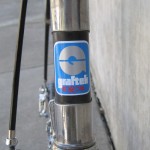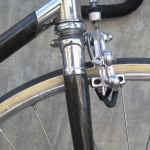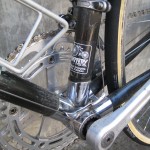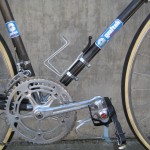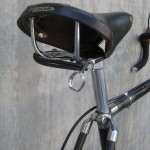1978 Exxon Graftek
Carbon fiber began working its way into sporting goods in the 1970′s. Ski poles, tennis rackets, fishing rods, and even golf clubs were designed with carbon structural elements or a layer of carbon fiber wrapped around them.
Enter Graftek. The sporting goods division of the Exxon corporation. We’re not sure if this was a nervous attempt at diversification during the OPEC oil embargo or merely a natural extension of their fishing rod factory, but Exxon designed and built carbon fiber bicycles from 1976 to 1978.
Built in South Plainfield, New Jersey, these bikes went into production alongside fishing rods and golf clubs. The frame design evolved over the three model years, but what you have here are stainless steel cast lugs, carbon-fiber wrapped aluminum tubing, and a carbon wrapped steel fork (which was an upgraded option for the final year of manufacture).
These bikes were a hit. Promoted by star American racer John Howard and the Exxon-Cool Gear racing team, Graftek bikes looked modern and high-tech to cyclists of the era. Besides the futuristic style, complete Graftek bikes ended up weighing one to two pounds less than contemporary steel Colnagos and similarly equipped Schwinn Paramounts.
Early versions featured chrome-plated Campagnolo dropouts and steel forks (with some of the forks painted to look like they were carbon).
Speaking of steel, we rode a steel Colnago with the same components and then tried out the Graftek to see how different the bikes would feel. The steering seemed quite similar, but there was a marked difference in sensation coming up through the pedals. The Graftek felt lighter (20.5 lbs vs. 22 lbs) and the feedback from the road was noticably muted. It was almost like the graftek had under-inflated tires. Imagine jumping up and down on a parquet basketball court (that’s the steel bike). By comparison, the Graftek would seem like you were jumping up and down on shag carpeting. In the late ’70′s, an era when different types of steel was really your only bike options, it would have been nice to be able to try out a Graftek.
This bike was originally owned by an Ohio native named Ron Alexander. His bike was saved from the trash heap by Jeremy Hutsell of Capp’s bike shop in Topeka Kansas. Big thanks to Jeremy for preserving this fun bit of cycling (and oil company) history.

